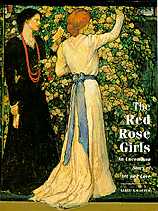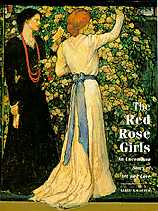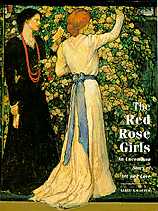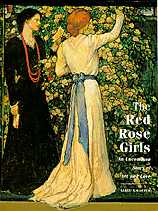


 |
#5 has Green art. |
I just finished reading The Red Rose Girls by Alice A. Carter. "Bunny" Carter is also the author of The Art of National Geographic. She's an art professor at nearby San Jose State College and the daughter of art historians Ben and Jane Eisenstat who lived a few miles from me when I originally wrote this in 2000. The Red Rose Girls documents the lives of artists Elizabeth Shippen Green, Jessie Willcox Smith and Violet Oakley (that's Oakley's art on the cover at left).
The three women met in Howard Pyle's illustration class. Green and Smith were charter members from 1894 and Oakley started in 1897. The women spent nearly 15 years of their professional and domestic lives together in a shared home/studio. Their early acquisition of a property called The Red Rose Inn gave them a name and Ms Carter a title for her book. It's a fascinating and thought-provoking read - the story of women and art and friendship in a changing society. It should be available at your local bookstore or check it out at your local library.

 Elizabeth Shippen Green was born in Philadelphia in 1871. Other artists
born within a year of her were F.R. Gruger, Orson Lowell, Eric
Pape, Maxfield Parrish,
Henry Reuterdahl, Charles
Robinson and W.H. Robinson.
Her father, Jasper Green, had been an artist/illustrator and encouraged
her choice of careers. At 17, she began submitting illustrations
to local newspapers and magazines. At 18, she enrolled at the
Pennsylvania Academy of Fine Arts, doing her assignments
both scholastic and professional from a makeshift studio in her
bedroom. At 23, she was a professional fashion illustrator for
the Ladies' Home Journal and one of the forty applicants
accepted for Howard Pyle's
first class in illustration at the Drexel Institute of Arts
and Sciences.
Elizabeth Shippen Green was born in Philadelphia in 1871. Other artists
born within a year of her were F.R. Gruger, Orson Lowell, Eric
Pape, Maxfield Parrish,
Henry Reuterdahl, Charles
Robinson and W.H. Robinson.
Her father, Jasper Green, had been an artist/illustrator and encouraged
her choice of careers. At 17, she began submitting illustrations
to local newspapers and magazines. At 18, she enrolled at the
Pennsylvania Academy of Fine Arts, doing her assignments
both scholastic and professional from a makeshift studio in her
bedroom. At 23, she was a professional fashion illustrator for
the Ladies' Home Journal and one of the forty applicants
accepted for Howard Pyle's
first class in illustration at the Drexel Institute of Arts
and Sciences.
It was there she met Jessie Willcox Smith and, in 1897, Violet Oakley. Smith and Green joined Oakley in her apartment studio that year. Oakley and Smith illustrated an edition of Evangeline that year. Green and Smith would collaborate on several early projects including a 1902 calendar for Bryn Mawr College and another calendar, later a 1903 book titled The Book of the Child, featuring illustrations of children
 Within
four years, Green had worked for such well-known magazines as
St. Nicholas (an 1898 illustration is at right) and The
Saturday Evening Post. And her illustration above left (from
the Post) was featured in the 1901 publication of The
Studio, Modern Pen Drawings European and American - one
of only 27 American illustrators so honored.
Within
four years, Green had worked for such well-known magazines as
St. Nicholas (an 1898 illustration is at right) and The
Saturday Evening Post. And her illustration above left (from
the Post) was featured in the 1901 publication of The
Studio, Modern Pen Drawings European and American - one
of only 27 American illustrators so honored.
The studio she shared with Smith and Oakley was soon outgrown and the women rented a large, English-style house and other buildings on a rural 200 acre estate called The Red Rose Inn. That same year, just one month shy of her 30th birthday, she signed an exclusive contract (as did Pyle and Edwin Austin Abbey) with Harper's Magazine for whom she would work for the next 23 years.

 This
exclusivity may sound like a restraint today, but Harper's published
such a variety of stories and was at the forefront of quality
color printing that Green was wonderfully situated to spend as
much or as little time painting as she wanted. I don't know if
she had any say in the types of material she illustrated, but
the images at left (1902) and right (1903) seem to indicate a
reasonable range of subjects.
This
exclusivity may sound like a restraint today, but Harper's published
such a variety of stories and was at the forefront of quality
color printing that Green was wonderfully situated to spend as
much or as little time painting as she wanted. I don't know if
she had any say in the types of material she illustrated, but
the images at left (1902) and right (1903) seem to indicate a
reasonable range of subjects.
The books in the case behind the child at right highlight a major difference between what might be found in a home, or perhaps even a child's library 100 years ago vs today. Included are: Pyle's Wonder Clock and Twilight Land, Hawthorne's Wonder Book, Kenneth Grahame's Dream Days (illustrated by Parrish), The Comedies of Shakespeare (with the Abbey illustrations), Alice's Adventures in Wonderland, The Blessed Damozel, Aucassin and Nicolette, and even the two volume Le Morte d'Arthur with the Beardsley illustrations.
After five years at the Red Rose Inn, the women moved in 1906 to a multi-dwelling setting they dubbed Cogslea (Cozens, Oakley, Green, Smith - Cozens being Henrietta Cozens who functioned as the household manager allowing the three artists to paint). Most issues of Harper's during the decade featured her work, quite often on the coveted color pages. She was often called upon to delineate stories featuring children and she did so with great sensitivity and aplomb. More often she painted a wide range of topics including potboilers and romances and displayed a flair for the dramatic and exotic that demonstrated the attention she had paid in Pyle's classroom.
Her penchant for accumulating large quantities of clippings which she carefully filed must have been an enormous help when she was asked to paint some of the unusual subjects that are found in her work.
 |
 |
 |
|
The Navarrese 1907 |
Tapestries of Twilight 1911 |
Beauty & the Jacobin 1912 |
 In
1911, Green married Huger (pronounced "u-gee") Elliott
and began signing her work Elizabeth Shippen Green Elliott or
simply ESGE in a manner very reminiscent of Howard Pyle's "Pyle".
She left her friends at Cogslea and tried to add wife and homemaker
to her accomplishments. After a somewhat rocky start, she managed
quite well. Fewer issues of Harper's featured her work,
but I believe that was more a sign of the times - there were simply
fewer illustrations in each issue. At left is the frontispiece
for the April 1918 Harper's issue.
In
1911, Green married Huger (pronounced "u-gee") Elliott
and began signing her work Elizabeth Shippen Green Elliott or
simply ESGE in a manner very reminiscent of Howard Pyle's "Pyle".
She left her friends at Cogslea and tried to add wife and homemaker
to her accomplishments. After a somewhat rocky start, she managed
quite well. Fewer issues of Harper's featured her work,
but I believe that was more a sign of the times - there were simply
fewer illustrations in each issue. At left is the frontispiece
for the April 1918 Harper's issue.
Her work for Harper's was also compiled into many books
as the serialized stories were recycled into the more permanent
medium. Old Country House (1902), The Book of the Child
(1903), Castle Comedy (1904), A Very Small Person
(1906), The Mansion (1911), The White People (1917).
In 1920 she moved back to a house near Cogslea. In 1924 she expanded
her market beyond Harper's, which by then was nearly 100%
text anyway, illustrating books for Houghton Mifflin, McKay, and
Doran. By the end of the 1920's, there was little demand for her
work in a marketplace dominated by magazines like Colliers
and The Saturday Evening Post featuring the works of Rockwell,
Pruett Carter, Cornwell,
Edwin Georgi, Rockwell Kent, John Lagatta, Mead Schaeffer and Leyendecker.
She faded into a happy retirement as what she described as one
of "Helen Hokinson's proper 'club' ladies"![]() and died in 1954 at 82.
and died in 1954 at 82.
Again I will recommend to you The Red Rose Girls (Abrams, 2000) by Alice A. Carter - most of the material in this essay is taken from that work. The images, with the exception of the small photo of ESG at the top are from the original pages of Harper's. The photo is taken from The Red Rose Girls (pg. 89) and is from the Archives of American Art.

To learn more about Elizabeth Shippen Green, visit
Nudelman
Fine Illustration or
Denise Ortakales' ESG page, or see:
| 200 Years of American Illustration | Henry C. Pitz, Random House 1977 |
| The Illustrator in America 1880 to 1980 | Walt and Roger Reed, Madison Square 1984 |
| American Illustration 1890-1925 | Judy L. Larson, Glenbow 1986 |
|
|
Alice A. Carter, Harry N. Abrams 2000 |
| The Vadeboncoeur Collection of Knowledge | Jim Vadeboncoeur, Jr. 2000 |
| The Vadeboncoeur Collection of ImageS B&W ImageS 5 | Jim Vadeboncoeur, Jr. JVJ Publishing 2010 |
|
Illustrations are copyright by their
respective owners. This page written, designed & © 2000 by Jim Vadeboncoeur, Jr. Updated 2011. |
